
After chopping around in a sideways range throughout the summer months, stocks are mostly hanging out near the same levels as the end of spring.
It’s commonly referred to as the “summer doldrums,” a phenomenon that occurs nearly every year due to seasonal volume declines in the stock market.
You know how those market-moving Wall Street big shots need to jet off to their holiday homes in the Hamptons every year, right?
The rest of us need to recharge our batteries too, and the end result is typically a lazy lack of direction in the stock market.
But even though most traders appreciate the summer downtime as a chance to “catch their breath,” stock operators also look forward to the fall because of the trend resolution the passing of summer usually brings.
In this blog post, we take a concise and objective look at ETFs of the main stock market indexes, so that we may have a view of the “big picture” trends of the major indices going into autumn of 2015.
Read on and be sure to jot down the key price support levels to watch in the coming weeks…
$SPY (S&P 500 ETF) – Pivotal Support Level Must Hold
The SPDR S&P 500, a popular ETF proxy for the S&P 500 Index, formed a bullish reversal bar last week that successfully defended the lows of the last significant reversal in early July.
Both of these reversals caused the price to dip below the pivotal 40-week moving average (same as 200-day moving average) in the prior week before reversing to close in the upper third of the week’s trading range and back above the 40-week moving average.
The ellipses on the weekly chart of $SPY below show the bullish reversal candlesticks:
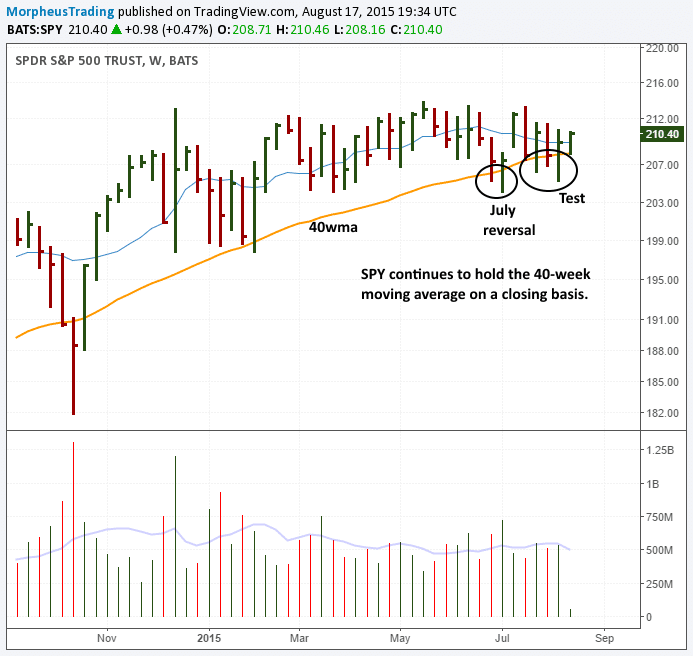
As long as the S&P 500 holds above its 40-week/200-day moving averages, odds favor an eventual resumption of the dominant uptrend.
The two bullish reversal bars also hint at higher prices, BUT all bets are off on near to mid-term strength if $SPY prints a weekly close below the low of two weeks ago ($204 to $205 level).
Such price action would convincingly put the price below key long-term support of the 40-week/200-day moving average, which would surely spark a spike in negative sentiment.
$QQQ (NASDAQ 100 ETF) – Barely A Market Leader
With an average of 100 to 200 million shares virtually trading hands nearly every day, Powershares QQQ Trust, which tracks the movement of the large-cap NASDAQ 100 Index, is one of the most heavily traded ETFs around.
Although its price gain over the summer doldrums was certainly nothing to write home about, the NASDAQ 100 has indeed been showing slight relative strength to the S&P 500 Index by closing each of the past six weeks above intermediate-term support of its 10-week moving average (same as 50-day moving average).
The NASDAQ 100 relative strength is confirmed by the fact that tech monsters such as $AMZN, $GOOG, $NFLX, $PLCN, and $FB have all moved to new 52-week highs and are presently holding up.
On the weekly chart below, notice how $QQQ has closed above its 10-week moving average (teal line) in each of the past six weeks:
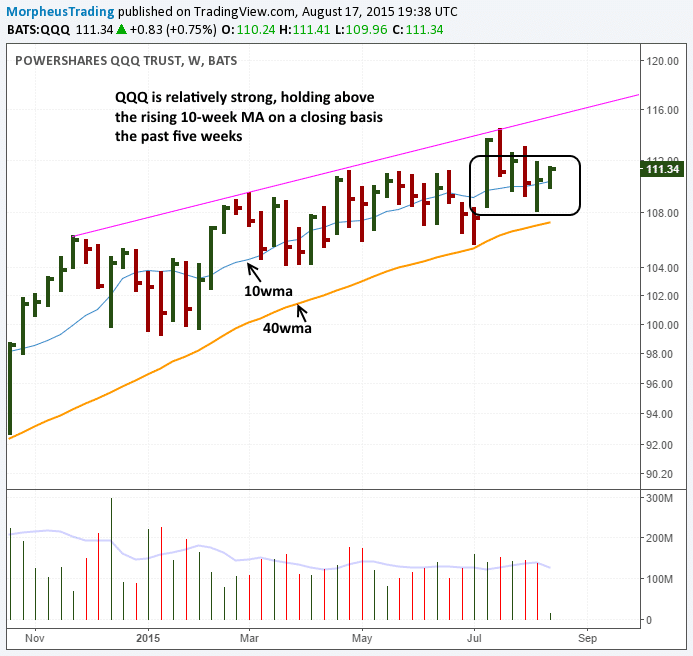
Even if $QQQ loses pivotal support of its 10-week moving average, the critical 40-week moving average (orange line) is still there to catch it.
Since it would be the first test of the 40-week moving average this year, the NASDAQ 100 should at least form a near-term reversal and bounce significantly higher off that level before heading much lower in the event of correction.
$MDY (S&P Midcap 400 ETF) – Clinging To Crucial Support
Like the S&P 500, buyers have repeatedly stepped in on dips below the 40-week moving average in $MDY, an ETF that facilitates trading the S&P Midcap 400 Index.
With two of the past three weeks printing bullish reversal bars, the $265 – $267 range is an important area of long-term price support that needs that should hold on a closing basis.
But as with the chart of $SPY, a breakdown below the prior lows would put $MDY in a precarious position:
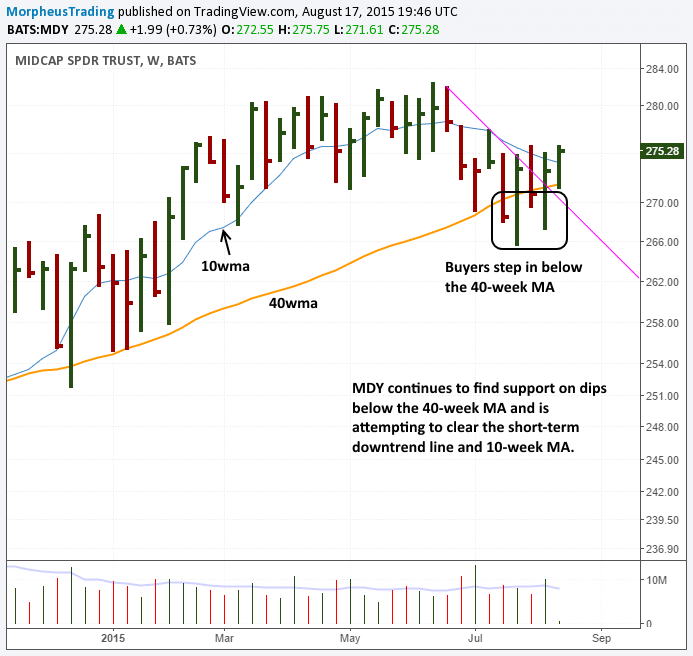
$IWM (iShares Russell 2000 ETF) – Moment Of Truth Is Near
The trend of small cap stocks is often a reliable indicator of the overall sentiment of the market.
When traders are feeling positive about future economic prospects, small caps frequently lead the rest of the major indices because speculators realize that such stocks typically have the greatest upside potential in bullish markets.
Conversely, money tends to flow out of small caps and into more “safe” blue chips when there is more uncertainty in the environment because investors become more conservative.
Given the above, we are NOT loving what we are seeing in the small-cap Russell 2000 Index (and $IWM) right now.
Take a look:
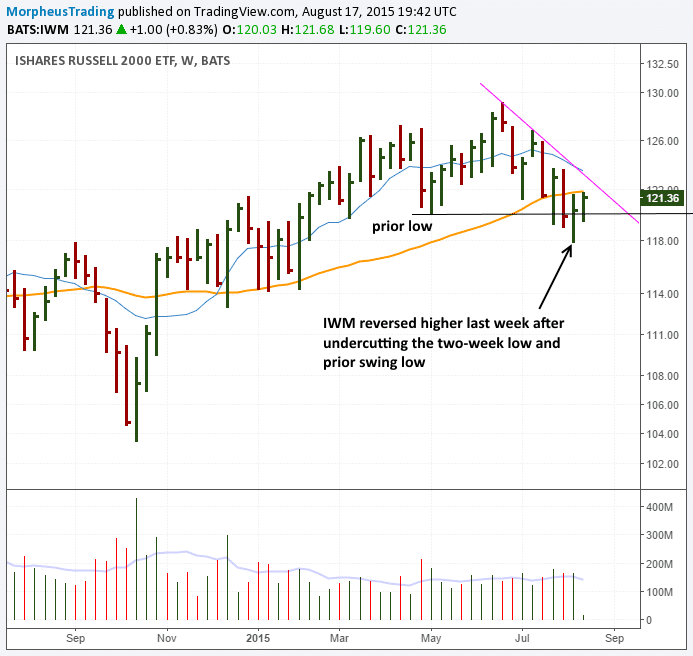
Along with its bearish close below the 40-week moving average in each of the past three weeks, $IWM also had a false breakout to new highs back in June.
When a stock or ETF breaks out above a valid base of consolidation, but quickly fails and slams back down into the prior trading range, the bulls who bought the breakout are forced to sell because they got trapped with the failed breakout.
Selling pressure from the bulls subsequently attracts the bears, who further add to the selling pressure.
The combination of 3 straight weeks closing below the 40-week moving average and the recent false breakout does give us cause for concern.
But don’t fret…at least not yet!
Despite showing relative weakness, $IWM recently “undercut” its prior two-week low before reversing to close in the upper half of the week’s range.
This might indicate bottoming action, but the key level to watch is around $118, as a break below the prior low of that reversal bar would be bad news and would definitely weigh on the rest of the major indices.
$TLT (iShares 20+ Year T-Bond ETF) – For The “Big Picture” Analysis
Although the performance of the bond market does NOT affect our day to day swing trading stock picks, having a general idea of how bond ETFs such as $TLT are performing helps us with our “bird’s eye view” of the overall market trends and sentiment.
When there is fear in the equities markets, money tends to flow out of stocks and into treasury bonds, so strength in $TLT might be considered bearish for the stock market (though this is NOT always the case).
On the weekly chart of the long-term bond ETF below, notice that $TLT is running into overhead resistance of its 40-week moving average.
If this resistance leads to a stall lower, we might expect small and midcap stocks to shine (at least in the near-term).
This is especially true if $TLT fails to hold above its rising 10-week MA.
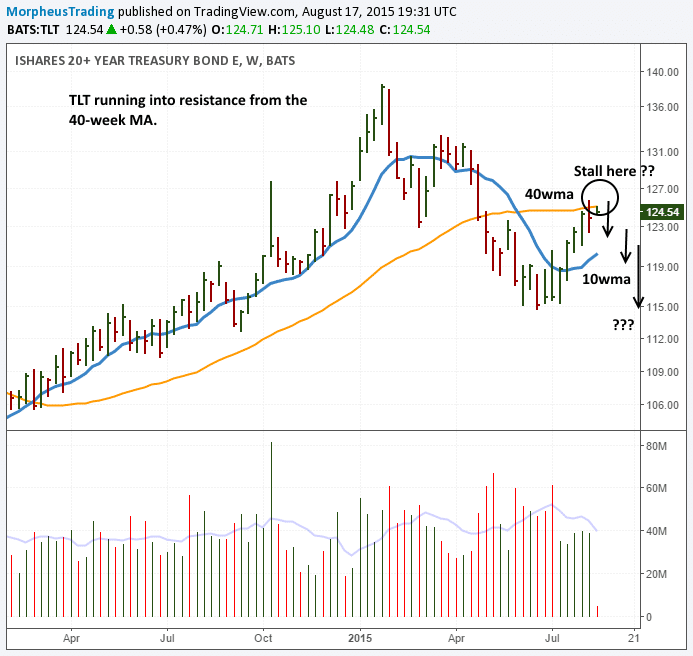
Bulls Still Have The Upper Hand (For Now)
If the weekly charts of the major stock indexes continue to put in “higher lows” throughout August and September (avoiding a breakdown below the prior lows is key), the market may still have enough gas for a healthy rally to close out the year.
But whether or not it plays out this way remains to be seen, as there are definitely some mixed signals creeping into the market.
As always, we never try to predict which way the market will go; we prefer to leave that to all the self-proclaimed “gurus” running amok.
Rather, our stock trading setups are simply based on putting the odds in our favor by objectively buying stocks with the greatest statistical odds for profit, then letting the chips fall where they may.
The market may still slightly favor the bulls, but market conditions can and do change in a flash (that’s why we always use protective stops).
Regardless of which direction the stock market resolves itself as it leaves the summer doldrums behind, our proven trading system (give it a try) has us covered either way.
Which way are stocks headed after the summer doldrums? We’d love to hear your thoughts by dropping a comment below.
